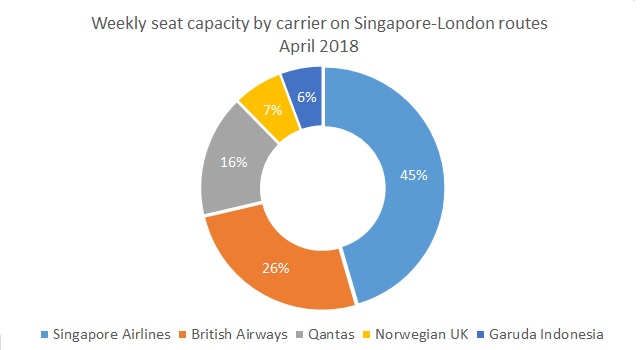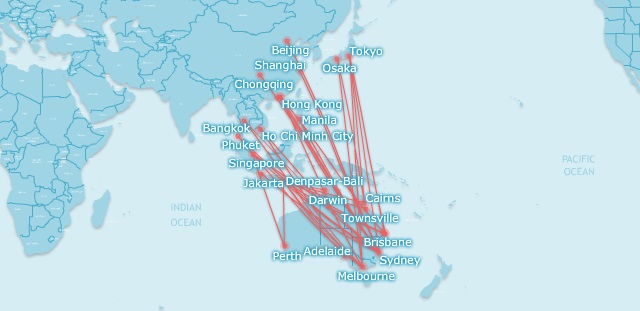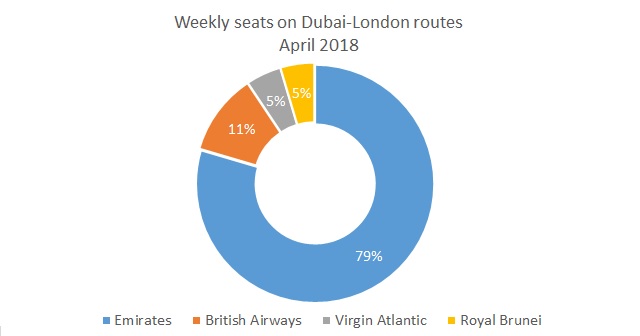Qantas’s reversion to operating its Sydney-London services via Singapore says much more about its Asian ambitions than its legacy focus on flying to Europe.
From 25 March 2018, the airline will shift its QF1/2 flights from Sydney to London that have operated via Dubai since April 2013 back onto the traditional 'Kangaroo route' via Singapore. Given that the carrier has already announced that it will cut its Melbourne-Dubai-London services at the same time, this will see Qantas stop flying to the Middle East using its own metal.
The move is part of a five-year extension to the alliance between Qantas and Emirates. Qantas chief executive Alan Joyce and Emirates president Tim Clark signed off on the new agreement on 30 August, and will now approach the Australian Competition and Consumer Commission for approval of the complex alliance arrangement.
Joyce insists that the change is a “win-win” and builds on a partnership that has created over $1 billion in value since it commenced in April 2012.
“This alliance has been a big success for both airlines, and a big success for our shared customers. Frankly it was a no-brainer to keep it going,” he told reporters during a media briefing following the announcement.
He adds that the two airlines expect the approval process for the updated alliance to run smoothly, since it will be based on the current approval.
Qantas expects the changes to deliver around A$80 million in net benefits during the 2019 fiscal year, although there will be some small costs in fiscal 2018 as it closes its Dubai station. Qantas International chief executive Gareth Evans says, however, that those will be negligible.
SLINGING IT TO LONDON, VIA SINGAPORE
Although Qantas already has a large presence in Singapore and experience in the market, the Singapore-London market has been through some important changes since it last operated the route in 2012.
FlightGlobal’s historical schedules data shows that when it withdrew, Qantas was the second largest carrier on the route in a three-horse race with Singapore Airlines and British Airways. When it re-enters the market in March, however, it will also be up against Garuda Indonesia and Norwegian UK, in addition to its old sparring mates.
Modelling by FlightGlobal based on today’s announcement and filed schedules data indicates that Qantas will be in third place, based on seat capacity, behind SIA and BA. Nonetheless, with Garuda and Norwegian operating less-than-daily frequencies, neither will be nipping at Qantas’s heels in any significant way.

Source: FlightGlobal schedules data via SRS Analyzer
Arguably, Norwegian is targeting leisure traffic that is unlikely to travel on Qantas’s services. Garuda’s presence, meanwhile, is more due to issues with Jakarta Soekarno-Hatta airport's runway pavement, preventing the airline from operating direct Jakarta-London services.
Qantas’s return to Singapore-London is, however, a significant threat to SIA, even though the latter remains the capacity leader on the route. The Star Alliance carrier has many more frequencies into Australia than Qantas does, but the Oneworld carrier also has a deep reach into the corporate travel market, with many of its clients happy to see the return of the Singapore stopover.
Evans says Qantas' Singapore-London services will depart during the evening bank, which will allow passengers from Melbourne, Brisbane, and Perth to connect onto the A380 service. In addition, Jetstar Asia and its codeshare partners will offer a range of other connections through Asia over the Singapore hub.
ASIA-FOCUSED MOVE
Although the changes appear largely linked to how Qantas operates its European network, Evans says that it is more closely tied to the airline's strategy of expanding its Asian footprint to meet the market's strong demand.
“It’s enabled us to continue to operate the strategy of laying the focus on Asia; we’re holding the current Asia-focused network and increasing the capacity into Asia,” says Evans.
That has seen the airline return to routes such as Sydney-Denpasar, launch Sydney-Beijing, and increased capacity to Japan in recent years. Joyce says the Qantas group, including discount offshoot Jetstar, now has “well over” half of its international capacity pointed into Asia.
Qantas and Jetstar routes from Australia to Asia - August 2017

FlightMaps Analytics
With the move of the A380 onto services from Melbourne and Sydney to Singapore, Joyce says that will allow Qantas to launch a new Asian destination using the A330 capacity that will be freed up.
“This is a very efficient way of going Melbourne-Singapore and Sydney-Singapore with the A380s, but also freeing up [the A330 from Melbourne] for further expansion into an Asian port that we will announce later,” says Joyce.
POSITIVE FOR EMIRATES
On its part, Emirates will lose some capacity on the Dubai-London leg since it codeshares on Qantas’s flights through to Heathrow. Joyce says however that Dubai will remain the major hub – and thus Emirates the primary carrier – for Qantas passengers travelling to destinations in Europe outside of London.
“The reality is the majority of customers travelling to London fly out of Australia on Qantas metal, and the majority of Qantas customers flying elsewhere in Europe fly out of Australia on Emirates metal. This is how the partnership has evolved and we’re very happy with that,” he adds.
Evans believes there will be upsides for both carriers, even as Qantas withdraws its metal from Dubai.
“By moving the flights there will be certain passengers and certain revenue, particularly the revenue going today on Qantas up to Dubai out of Sydney connecting onto Europe will transfer over to Emirates. We will then be operating out of Asia and we will be participating in a new revenue flow: O&D between Singapore and London and between London and other Asian destinations over Singapore.”
Australia is a major market for Emirates, which operates 77 weekly services from Dubai to Australian destinations, including a daily service to Sydney via Bangkok, and onward services to New Zealand. Clark foreshadowed however that there will be some changes ahead under the renewed alliance.
“We see an opportunity to offer customers an even stronger product proposition for travel to Dubai, and onward connectivity to our extensive network in Europe, Middle East, and Africa. We will announce updates in the coming weeks,” he says.
Losing access to the Qantas-operated Dubai-London flights will reduce some of Emirates’ codeshare capacity on the route, but that may prove to be more of a blessing than a curse.
FlightGlobal schedules data shows that while Emirates is by far the largest operator of seats between the two cities, it competes against BA, Virgin Atlantic and Royal Brunei on the route. The loss of Qantas’s capacity will see its share of seat capacity rise to 79%, based on FlightGlobal modelling.

Source: FlightGlobal schedules data via SRS Analyzer
That will help to consolidate the market at a time when Emirates is struggling with lower yields across its network and signs of overcapacity in the Middle East.
Far from being a snub of Emirates, Qantas’s focus on growing its Asian network will deliver some strong benefits.
Source: Cirium Dashboard



















